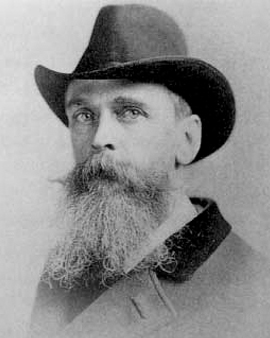Im Jahre 1872 wurde die einzigartige Landschaft des Yellowstone für schützenswert empfunden und der erste Nationalpark gegründet. Das unwegsame Gelände stand lange nicht im Fokus der verantwortlichen Politiker. 1871 brach ein Vermessungsteam auf, um den Westen er USA zu erkunden. Unter ihnen der Künstler Thomas Moran. Der gebürtige Engländer war mit seinen Eltern über den Ozean ausgewandert, als das industrielle England in wirtschaftlich schwierige Zeiten kam. Thomas Moran zog seine Inspiration aus den Werken Turners. Entmaterialisierte Gemälde, dessen Wirkung auf dem Spiel von Licht und Farbe basierte, vermochten britische Künstler mit großem Geschick umzusetzen. In Amerika hatten die Maler um die Hudson River School die Maßstäbe der Landschaftsmalerei neu definiert. Thomas Cole war Gründer der Vereinigung und verlieh der Entwicklung zwischen Natur und Bevölkerung eine harmonische Atmosphäre.
Thomas Moran fing als erster Maler die gewaltigen Canyons und sprudelnden Geysire der dramatischen Landschaft ein. Seinen Darstellungen ist es zu verdanken, das sich das Bewusstsein für den Schutz von Yellowstone und dem Grand Canyon in der Gesellschaft verfestigte. Moran schaffte mehr, als die reine Abbildung. Seine leicht idealisierten Darstellungen brachten die Gesellschaft dazu, die Landschaft ebenfalls mit einem verklärten Blick zu betrachten. Ein Talent mit dem nur wenige Maler überzeugen konnten. Moran greift eine Ästhetik auf, die charakteristisch für die Künstler der amerikanischen Ostküste ist. Wie einen sanften Filter legt er den kunstsinnigen Eindruck über die wild-raue Landschaft im Westen des Landes. Das Gemälde Der Grand Canyon des Yellowstone spricht den Betrachter durch die besondere Farbigkeit an. Moran verfügte über hervorragende topografische Kenntnisse, die er durch Licht und Farbe der Wirklichkeit entrückt. Der Künstler traute sich nach eigenen Worten an das Größte, Schönste oder Wundervollste der Natur heran und präsentierte seine Werke auf großen Leinwänden. Seine Darstellung des Grand Canyon nannte er liebevoll „mein großes Bild“. Der Grand Canyon bildet ein Fundament der kulturellen Identität Amerikas. Das Gemälde Morans fand nach seiner Fertigstellung einen Platz im Kapitol und sicherte dem Maler künstlerischen Erfolg.
Thomas Moran war an der Ostküste zu Hause und nahm die Impulse auf, die aus den Strömungen der europäischen Kunst Einfluss nahmen. Seine Motive fand der Künstler jedoch auf Reisen. Moran nahm weiterhin an Expeditionen durch Yellowstone teil und besuchte Mexiko und Europa. Neben seinen eindrucksvollen Landschaftsansichten versuchte er sich an Darstellungen des städtischen Lebens und industriellen Entwicklungen. Seine Skizzen kolorierte er mit Aquarell und ließ die Fülle der Farbigkeit im Atelier auf die Leinwand fließen. Moran betonte zeitlebens wie sicher er aus seinem Gedächtnis die Merkmale der Landschaft und die Kombination der Farben in seinem Atelier zusammenbringen konnte. Der Maler war über das achtzigste Lebensjahr hinaus produktiv und hinterlässt ein Werk mit einem unvergleichlichen Umfang.
×





.jpg)
.jpg)
.jpg)
.jpg)
.jpg)
.jpg)
.jpg)
.jpg)
.jpg)
.jpg)
.jpg)
.jpg)
.jpg)
.jpg)
.jpg)
.jpg)
_-_(MeisterDrucke-1490487).jpg)
_-_(MeisterDrucke-1490487).jpg)
.jpg)
.jpg)
.jpg)
.jpg)
.jpg)
.jpg)
.jpg)
.jpg)
.jpg)
.jpg)
.jpg)
.jpg)
.jpg)
.jpg)
.jpg)
.jpg)
.jpg)
.jpg)
.jpg)
.jpg)
.jpg)
.jpg)
.jpg)
.jpg)
.jpg)
.jpg)
.jpg)
.jpg)
_-_(MeisterDrucke-899237).jpg)
_-_(MeisterDrucke-899237).jpg)
.jpg)
.jpg)
.jpg)
.jpg)
.jpg)
.jpg)
.jpg)
.jpg)
.jpg)
.jpg)
.jpg)
.jpg)
.jpg)
.jpg)
.jpg)
.jpg)
_-_(MeisterDrucke-898421).jpg)
_-_(MeisterDrucke-898421).jpg)
.jpg)
.jpg)
.jpg)
.jpg)
.jpg)
.jpg)
.jpg)
.jpg)
.jpg)
.jpg)
.jpg)
.jpg)
.jpg)
.jpg)
.jpg)
.jpg)
.jpg)
.jpg)
.jpg)
.jpg)
.jpg)
.jpg)
.jpg)
.jpg)
.jpg)
.jpg)
.jpg)
.jpg)
_-_(MeisterDrucke-1126106).jpg)
_-_(MeisterDrucke-1126106).jpg)
.jpg)
.jpg)
.jpg)
.jpg)
.jpg)
.jpg)
.jpg)
.jpg)
.jpg)
.jpg)
.jpg)
.jpg)
.jpg)
.jpg)
.jpg)
.jpg)
.jpg)
.jpg)
.jpg)
.jpg)
.jpg)
.jpg)
.jpg)
.jpg)
.jpg)
.jpg)
.jpg)
.jpg)
.jpg)
.jpg)
.jpg)
.jpg)
.jpg)
.jpg)
.jpg)
.jpg)
.jpg)
.jpg)
.jpg)
.jpg)
.jpg)
.jpg)
.jpg)
.jpg)
.jpg)
.jpg)
_-_(MeisterDrucke-1603700).jpg)
_-_(MeisterDrucke-1603700).jpg)
.jpg)
.jpg)
.jpg)
.jpg)
.jpg)
.jpg)
.jpg)
.jpg)
.jpg)
.jpg)
.jpg)
.jpg)
.jpg)
.jpg)
.jpg)
.jpg)
.jpg)
.jpg)
.jpg)
.jpg)
_-_(MeisterDrucke-1603300).jpg)
_-_(MeisterDrucke-1603300).jpg)
.jpg)
.jpg)
.jpg)
.jpg)
_-_(MeisterDrucke-1133523).jpg)
_-_(MeisterDrucke-1133523).jpg)
_-_(MeisterDrucke-1087545).jpg)
_-_(MeisterDrucke-1087545).jpg)
.jpg)
.jpg)
.jpg)
.jpg)
.jpg)
.jpg)
.jpg)
.jpg)
.jpg)
.jpg)
.jpg)
.jpg)
.jpg)
.jpg)
.jpg)
.jpg)
.jpg)
.jpg)
.jpg)
.jpg)
.jpg)
.jpg)
.jpg)
.jpg)






